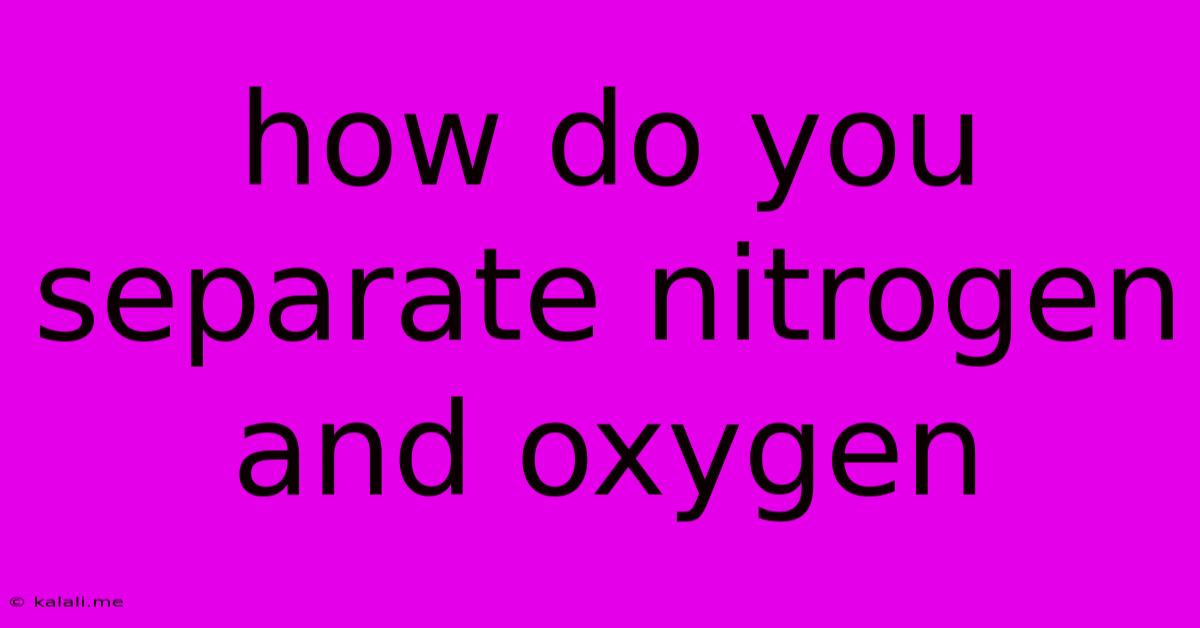How Do You Separate Nitrogen And Oxygen
Kalali
Jun 13, 2025 · 3 min read

Table of Contents
How Do You Separate Nitrogen and Oxygen? A Deep Dive into Gas Separation Techniques
Air, the very breath we take, is a mixture, predominantly of nitrogen (approximately 78%) and oxygen (approximately 21%), along with trace amounts of other gases like argon, carbon dioxide, and neon. Separating these gases, particularly nitrogen and oxygen, is a crucial process with wide-ranging industrial applications, from food preservation to steel production. But how is it done? This article explores the common methods used to separate these two vital components of air.
Understanding the Challenge: Similar Properties, Different Needs
Nitrogen and oxygen are both relatively inert gases at standard temperature and pressure. Their chemical similarities make straightforward separation challenging. However, subtle differences in their physical properties, particularly boiling points, are exploited in various separation techniques. Oxygen has a slightly higher boiling point than nitrogen (-183°C vs -196°C), a key factor in the most common separation methods.
Fractional Distillation: The Workhorse of Air Separation
Fractional distillation is the most widely used industrial method for separating nitrogen and oxygen. This process leverages the difference in boiling points. Here's how it works:
-
Air Compression and Purification: Air is first compressed, cooled, and purified to remove contaminants like water vapor, carbon dioxide, and hydrocarbons. This ensures efficient and safe separation.
-
Liquefaction: The purified air is then cooled further until it liquefies. This requires significant energy, typically achieved through a complex series of heat exchangers and expansion turbines.
-
Distillation: The liquid air is fed into a fractional distillation column, a tall tower with many trays or packing materials. As the liquid air ascends the column, its temperature gradually decreases. Nitrogen, with its lower boiling point, vaporizes first and is collected at the top. Oxygen, with its higher boiling point, remains liquid for longer and is collected lower down.
-
Product Collection: The collected nitrogen and oxygen gases are then further purified and stored or used directly in various applications.
Other Separation Methods: Exploring Alternatives
While fractional distillation dominates industrial-scale separation, other methods exist, although often with niche applications:
Membrane Separation:
This technique uses semi-permeable membranes that allow smaller nitrogen molecules to pass through faster than larger oxygen molecules. While less energy-intensive than distillation, it's generally less efficient at achieving high purity levels for both gases. This method is more suitable for smaller-scale operations or situations where high purity isn't paramount.
Pressure Swing Adsorption (PSA):
PSA utilizes adsorbent materials (like zeolites or activated carbon) with a higher affinity for oxygen than nitrogen. Under pressure, oxygen adsorbs onto the material, leaving nitrogen to pass through. The process then reverses by reducing the pressure to release the adsorbed oxygen. PSA is often used for smaller-scale nitrogen generation, such as on-site production for industrial processes.
Cryogenic Air Separation Units (CASUs):
These advanced systems combine various techniques, including expansion turbines and heat exchangers, to achieve highly efficient liquefaction and separation of air components. CASUs are employed for large-scale applications where high purity and volume of separated gases are required.
Conclusion: A Vital Process with Diverse Applications
Separating nitrogen and oxygen from air is a crucial technological feat with far-reaching consequences. Fractional distillation remains the dominant method for large-scale production, but membrane separation and PSA provide viable alternatives for specific needs. Understanding the principles and methods behind these techniques highlights the ingenuity involved in harnessing the properties of gases for a wide range of industrial and commercial applications. The continuous development and optimization of these separation processes are essential for meeting the ever-growing demands for pure nitrogen and oxygen across various sectors.
Latest Posts
Latest Posts
-
What Is The Opposite Of Frugal
Jun 14, 2025
-
How To Get Pkb From Kb
Jun 14, 2025
-
What Is The Factors Of 225
Jun 14, 2025
-
Discounting Is The Opposite Of
Jun 14, 2025
-
The Unit Of Measure For Capacitive Reactance Is The
Jun 14, 2025
Related Post
Thank you for visiting our website which covers about How Do You Separate Nitrogen And Oxygen . We hope the information provided has been useful to you. Feel free to contact us if you have any questions or need further assistance. See you next time and don't miss to bookmark.